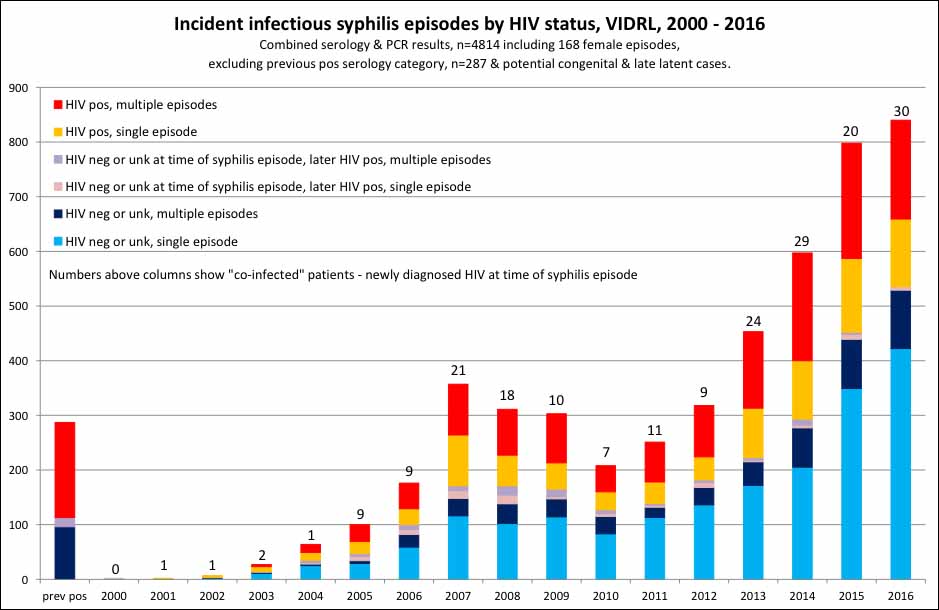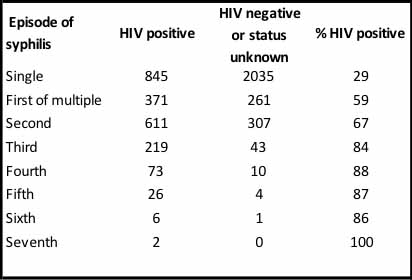03 Apr 2018
The evolving syphilis epidemic in Victoria
Syphilis, a sexually transmitted infection (STI) caused by the spirochaete pathogen Treponema pallidum, has undergone a major resurgence in many developed countries with typically low incidence over the past two decades [1] [2] [3]. This resurgence is reflected in Victoria, with 1323 cases of infectious syphilis reported to the Victorian DHHS in 2017. In comparison, there were no locally acquired cases reported in 2000 and 2001[4]. Much of this resurgence has been driven by infections in men who have sex with men (MSM), and almost half of the cases notified in recent years have been in human immunodeficiency virus (HIV) positive MSM [5].
Syphilis infection has been found to be closely associated with HIV infection (Figure 1), facilitating both HIV transmission and acquisition [6] [7]. HIV positive MSM represent a disproportionate number of syphilis cases (Figure 1) and cases with frequent re-infections (Table 1), and suffer asymptomatic episodes that may only be detected by frequent screening [8]. Syphilis presentation can be extremely variable, and if untreated it may cause potentially fatal neurological, cardiovascular, or congenital disease, with two cases of the latter reported in Victoria in 2017 [9].

Figure 1: Incident infectious syphilis episodes by HIV status, VIDRL, 2000-2016

Table 1: HIV positivity by syphilis episode since 2000
VIDRL has been responsible for testing and notifying >70% of Victorian infectious syphilis cases over the past few years. VIDRL provides the most comprehensive range of diagnostic tests for syphilis available in Victoria, including T. pallidum specific serological assays such as chemiluminescent immunoassay (CLIA – used as the screening test), T. pallidum particle agglutination assay (TPPA – used as a confirmatory assay which has added sensitivity in suspected early cases) and IgM EIA for detection of early cases and congenital infection. A Fluorescent Treponemal Antibody (FTA) assay is available for testing CSF for neurosyphilis diagnosis. Disease activity is monitored using the Rapid Plasma Reagin assay (RPR), which can be titred and usually declines following treatment, or if rising can indicate reinfection or treatment failure. VIDRL has also developed a real-time PCR assay for direct detection of T. pallidum in muco-cutaneous lesions or tissue biopsies. This assay targets a sequence specific to the T. pallidum DNA polymerase A gene, and will also detect T. pallidum subspecies pertenue – the cause of the tropical disease Yaws. This assay has been in routine diagnostic use since 2004 and has been replicated in overseas institutions. Other diagnostic or typing PCR-based assays are also available or under development.
At present VIDRL is involved in a research project with Melbourne Sexual Health Centre (MSHC) using PCR to look at potential asymptomatic shedding and dissemination of T. pallidum in early infectious syphilis, and is collaborating with the Microbiological Diagnostic Unit Public Health Laboratory (MDU) in a whole genome sequencing study. With relatively few institutions currently studying syphilis worldwide, there are numerous research opportunities in the basic biology, pathogenesis, immunology, and treatment of this complex re-emerging disease.
Authors: David Leslie (VIDRL), Theo Karapanagiotidis (VIDRL), Franca Azzato (VIDRL), Janet Towns (MSHC)


